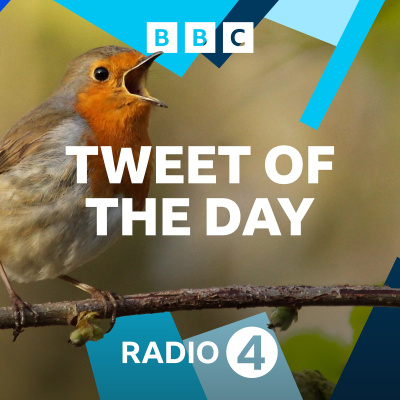Sinopsis
Discover birds through their songs and calls. Each Tweet of the Day begins with a call or song, followed by a story of fascinating ornithology inspired by the sound.
Episodios
-
Hoopoe
17/04/2014 Duración: 01minTweet of the Day is a series of fascinating stories about our British birds inspired by their calls and songs.Kate Humble presents the hoopoe. The hoopoe, a salmon-coloured bird with a long curved bill and a black-tipped crest, which it can spread like a fan when excited, is so outrageously exotic that its call reminds us of the Mediterranean. Several hoopoes arrive in the UK each spring and autumn. These are usually birds which have overshot their migration routes and almost certainly won't find a mate here, though they do breed very occasionally.
-
Green Woodpecker
16/04/2014 Duración: 01minTweet of the Day is a series of fascinating stories about our British birds inspired by their calls and songs. Kate Humble presents the green woodpecker. The maniacal laughing call, or 'yaffle', of a green woodpecker was supposed to herald rain, hence its old country name of 'rain bird'. You can hear their yodelling calls in woods, parks, heaths and large gardens throughout most of the UK. Altough green woodpeckers do nest in trees they spend a lot of their time on the ground, probing lawns and meadows for their main food, ants and their pupae.
-
Meadow Pipit (Spring)
15/04/2014 Duración: 01minTweet of the Day is a series of fascinating stories about our British birds inspired by their calls and songs. Kate Humble presents the meadow pipit. No-one would give the meadow pipit any prizes in a beauty competition but this small streaky bird has its own charm, as it bustles through the turf with a jerky motion. If you're hiking across the moor it will rise ahead of you, dither in mid-air and then dart off, buffeted by the spring breeze.
-
Swallow (Spring)
14/04/2014 Duración: 01minTweet of the Day is a series of fascinating stories about our British birds inspired by their calls and songs. Kate Humble presents the swallow. A flash of blue across farmland or a stableyard and a burst of twittering can only mean one thing, the swallows are back after their long migration from South Africa. No matter how grey the April weather, the sight and sound of a swallow dispels the winter blues at a stroke. These agile migrants arrive as the insect population is beginning to increase, and they are a delight to watch as they hawk for flies in the spring sunshine.
-
Common Whitethroat
11/04/2014 Duración: 01minTweet of the Day is a series of fascinating stories about our British birds inspired by their calls and songs. Kate Humble presents the common whitethroat. Whitethroats are warblers which winter in the Sahel region south of the Sahara desert and spend spring and summer in Europe. When they arrive in April the males establish a territory by singing that scratchy song from hedgerow perches or by launching themselves into the air.
-
Great Grey Shrike
10/04/2014 Duración: 01minTweet of the Day is a series of fascinating stories about our British birds inspired by their calls and songs. Kate Humble presents the great grey shrike. Great grey shrikes feed on small birds, which they can catch in flight. They also eat mice, voles and shrews and, as spring approaches, they'll include bees and larger beetles in their diet. Shrikes are also known as "butcher birds" because of their habit of impaling their prey on thorns, just as a butcher hangs his meat on hooks.
-
Grasshopper Warbler
09/04/2014 Duración: 01minTweet of the Day is a series of fascinating stories about our British birds inspired by their calls and songs. Kate Humble presents the grasshopper warbler. The reeling song of the grasshopper warbler sounds more like an insect than a bird. Like the paying out of an angler's line from a reel, the grasshopper warbler's song spills out from the bush or bramble clump in which he sits. You'll hear it most often at dawn or dusk in overgrown scrubby or marshy areas.
-
Bittern
08/04/2014 Duración: 01minTweet of the Day is a series of fascinating stories about our British birds inspired by their calls and songs. Kate Humble presents the bittern. As the first shoots of spring appear in the reed-beds, you might hear the booming sound of a bittern. The bittern's boom is lower pitched than any other UK bird and sounds more like a distant foghorn than a bird. Today these birds are on the increase, thanks to the creation of large reed-beds.
-
Curlew (Spring)
07/04/2014 Duración: 01minTweet of the Day is a series of fascinating stories about our British birds inspired by their calls and songs. Kate Humble presents the curlew. The haunting song of the curlew instantly summons the spirit of wild places. By April, most curlews have left their winter refuge on estuaries and marshes and have returned to their territories on moorland or upland pastures. Wherever they breed you'll hear the male birds singing and displaying. It's often called the bubbling song.
-
Snipe
04/04/2014 Duración: 01minKate Humble presents the snipe. The snipe is an intricately patterned wader, not much bigger than a blackbird but with an enormously long bill. In the breeding season they fly high above their territories before dashing earthwards and then sweeping upwards again. Throughout this display you'll hear a bleating sound, known as 'drumming'. Find out how the sound is made in today's programme.Producer Sarah Blunt
-
Willow Warbler
03/04/2014 Duración: 01minTweet of the Day is a series of fascinating stories about our British birds inspired by their calls and songs. Kate Humble presents the willow warbler. The first willow warblers return from Africa in late March. Willow warblers were once the commonest and most widespread summer migrant to the UK but in the last two decades numbers in the south and east of England have dropped. Fortunately in Scotland, Ireland and the west, numbers seem to be holding up.
-
Black Grouse
02/04/2014 Duración: 01minTweet of the Day is a series of fascinating stories about our British birds inspired by their calls and songs. Kate Humble presents the story of the black grouse. A black grouse lek is one of Nature's spectacles. Charged with testosterone, the males, known as 'black cocks', compete on 'jousting lawns' for the females or grey hens. Fanning their lyre-shaped tails and displaying a flurry of white undertail feathers, the males rush towards their rivals with harsh scouring sneezes and bubbling cries, known as 'roo-kooing'.
-
Woodcock
01/04/2014 Duración: 01minTweet of the Day is a series of fascinating stories about our British birds inspired by their calls and songs. Kate Humble presents the woodcock. Woodcocks are waders, thickset, long-billed, and superbly camouflaged. On the woodland floor, where they hide by day, their rust, fawn and black plumage conceals them among the dead leaves of winter. Often the first sign that they're about is a blur of russet and a whirr of wings as a woodcock rises from almost under your feet and twists away between the tree-trunks.
-
Ring Ouzel
31/03/2014 Duración: 01minTweet of the Day is a series of fascinating stories about our British birds inspired by their calls and songs. Bill Oddie presents the ring ouzel. Ring ouzels are related to blackbirds and because they nest in the uplands, they’re sometimes known as the ‘mountain blackbird’. The male ring ouzel is a handsome bird, sooty black with a broad white ring called a ‘gorget’ right across his chest that stands out like a beacon. Unfortunately these summer visitors are becoming harder to find even in their strongholds, which include the North York Moors and several Scottish and Welsh mountains.
-
Big Bird
29/03/2014 Duración: 01minAs part of Radio 4's Character Invasion, Chris Packham presents a unique Tweet of the Day to tell the story of Big Bird.Avis giganteus, is , as its scientific name suggests, a large, conspicuous and highly vocal species, and one of the few birds for which binoculars are redundant. At a staggering 249 cm high, it is over-topped only by the male ostrich. But while the ostrich is an athletic creature of wild open spaces, our bird is a denizen of urban thoroughfares and film studios.
-
Black Redstart
28/03/2014 Duración: 01minTweet of the Day is a series of fascinating stories about our British birds inspired by their calls and songs. Bill Oddie presents the black redstart. It was the German Luftwaffe which enabled black redstarts to gain a real foothold here. The air-raids of the Blitz created bombsites which mimicked their rocky homes and the weeds that grew there attracted insects. In 1942 there over twenty singing males in London alone and now they're being encouraged by the creation of ‘green roof’ habitats, rich in flowers and insects.
-
Little Ringed Plover
27/03/2014 Duración: 01minTweet of the Day is a series of fascinating stories about our British birds inspired by their calls and songs. Bill Oddie presents the little ringed plover. In 1938, there was great excitement at a Hertfordshire reservoir. On the gravelly shoreline a pair of birds, which had never bred in the UK before, were showing signs of nesting. They were little ringed plovers, summer visitors to Continental Europe and they'd been attracted to the reservoirs' shingle banks where they laid their clutch of four eggs. Today there are around a thousand pairs in the UK.
-
Ruff
26/03/2014 Duración: 01minTweet of the Day is a series of fascinating stories about our British birds inspired by their calls and songs. Bill Oddie presents the ruff. The glory of the ruff lies in its extravagant courtship displays. For most of the year these waders look similar to our other long-legged water-birds such as redshanks or sandpipers but in the breeding season the males sprout a multi-coloured ruff. The impressive ruffs of feathers come in infinite variety, black, white, ginger, or a mixture of these. The males gather at traditional spring leks with the aim of winning one or more mates.
-
Alpine Swift
25/03/2014 Duración: 01minTweet of the Day is a series of fascinating stories about our British birds inspired by their calls and songs. Bill Oddie presents the alpine swift. Alpine swifts are impressive anchor-shaped birds, the colour of coffee above and milk-white below. In the UK Alpine swifts are annual visitors, appearing in Spring, but they don't breed here. They spend the winter in Africa and on their journey north in spring some birds overshoot their breeding areas. Alpine swifts can be seen as they arc through the skies and because they travel so fast they can turn up almost anywhere from central London to Shetland.
-
Egyptian Goose
24/03/2014 Duración: 01minTweet of the Day is a series of fascinating stories about our British birds inspired by their calls and songs. Bill Oddie presents the Egyptian goose. Although Egyptian geese are common throughout most of sub-Saharan Africa and in Egypt, they are now officially a British bird. These striking birds attracted the attention of wildfowl collectors and the first geese were brought to the UK in the 17th century. By the 1960's it became obvious that the geese were breeding in the wild in East Anglia and since then they've spread in south and eastern England.














